
The little known “E” class
The two Enterprise (Enterprise and Emerald) or “E” class vessels were the last British light cruisers built during the Great War. However, the lack of manpower and shipbuilding priority given to destroyers meant that their launch only took place in 1920. They were only completed, with much revisions, in 1926. They were originally built to counter Fast cruisers, the German minelayer Brummer and Bremse, operating at the end of 1917. They could achieve 33 knots, using engines from the Shakespeare class flotilla leaders mounted in pairs, with classical artillery derived from “D” class.
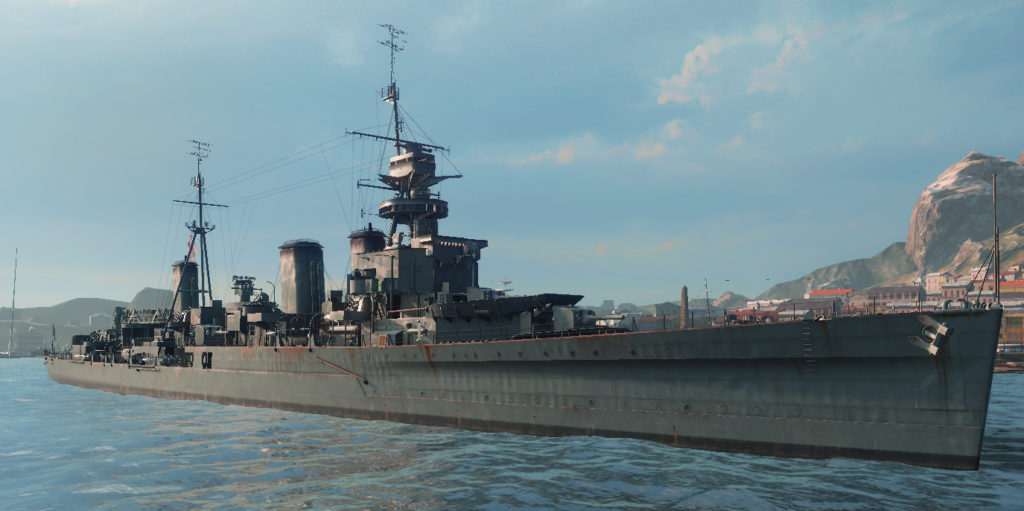
WoW’s rendition of the Emerald.
The Emerald class was the last class of light cruisers planned and ordered during the great war. Three ships were ordered, HMS Emerald (laid down 23.9.1918), Enteprise (laid down 28.6.1918) and Euphrates (plannes to be laid down in November 1918 but cancelled). These were considered improved “D” class cruisers with a displacement of almost 10,000 tonnes fully loaded, compared to 5800 for the Danae. The ships were launched well after the war, in 1919 and 1920 but the first was completed and in service in january 1926 therefore the class was named after the Emerald and not the Enterprise. Their carrer in the interwar was quite active and both served throughout WW2 with distinction in many theaters of operations.
Three ships has been laid down, the third called HMS Euphrates being laid down at Fairfield Shipbuilding and Engineering Company, Govan in 1918 but cancelled shortly after on 26 November 1918. The first pencil lines had been laid in 1917 and much of their equipment was 1916 standard. With a complement of four sets of torpedo tubes, these ships were quite formidable for 1918, but in 1926 after their lengthy completion, this design was quite dated.
Design
The two ships were thin, being longer without increase in beam. To afford the extended machinery and double the power available, reaching 33 knots (61 km/h; 38 mph), gaining 30 m in length at the expense of almost 50% more displacement. Four propellers were driven from two engine rooms, four boiler rooms, the 2 and 3 being arranged side-by-side and trunked into a common funnel, while the 1 and 4 each had their own funnel, but the 4 was much further aft, which gave this very recognizable and unusual silhouette. The truth was they emphasised high speed at the cost of other qualities.
The class would be reclassified as light cruisers thereafter. Their artillery comprised only one more gun than previous Danae class, with the last 152 mm single mounts: Seven pieces including port and starboard on the fore deck for the Emerald, and a twin turret for the Enterprise, the first to experiment one at that time for this light caliber. The twin turret was a prototype, successfully tested, that led to its adoption on the Leander, Amphion and Arethusa classes. In consequence the bridge was of a new design, and some features like a single block topped by a director tower would soon appear also on the ‘County’ class cruisers.
The two ships received a catapult for a seaplane in 1936, which will be deposited in 1944, because in the meantime they were equipped with efficient radars. Their torpedo tubes were replaced in 1929. Finally, their AA artillery was reinforced in 1940, with the addition of two quadruple Bofors 40 mm mounts, while in 1942 their benches of torpedo tubes were deposited in favor of 16 to 18 20 mm pieces Oerlikon AA. Until 1939 they were both stationed in the Far East and also in the Mediterranean.
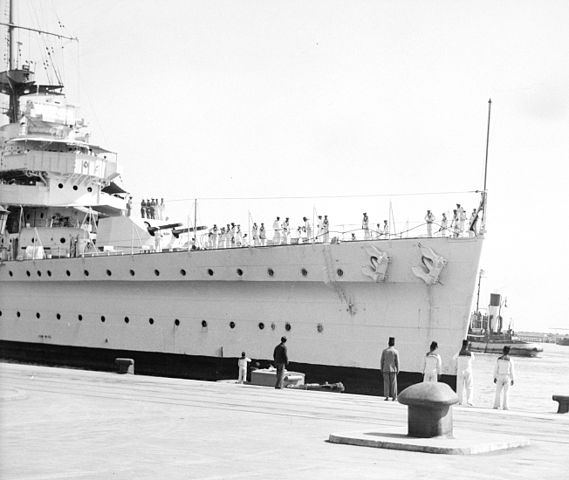
Detail of the front twin turret, HMS Enterprise 1936
Career: HMS Enterprise
The HMS Enterprise served off the coast of France, carried out escort missions, participated in the Norwegian campaign, fought in Narvik and was badly hit there. After repairs, she joined H force in the Mediterranean, participating in operation “Catapult” against the French navy anchored at Mers-el-Kebir.
She then departed for the Indian Ocean and the Far East. later she returned to France for a refit and was assigned to the hunt for the German raiders. In December 1943 she engaged and destroyed a German destroyer and two torpedo boats, taking part in escort missions until June 1944, assisting the landing by battery cover. In January 1945 she was transferred to the reserve and made only secondary missions such as the repatriation of troops. She was disarmed and demolished in 1948.
Career: HMS Emerald
The HMS Emerald received radars and new tripod masts in 1940, losing a 152 mm piece. She crossed the North Atlantic, carrying the British gold reserves to Halifax (58 million pounds). She was then assigned to the Indian Ocean. She returned in 1941 to the Mediterranean and the Persian Gulf. She operated on the Iraqi coast (to support the repression of a pro-German revolt in the summer of 1941) and the Red Sea. In December, she was part of famous Z force at Singapore (also Prince of Wales and Repulse). She did not departed with the ships of Tom Philips on their fatal raid, and became after their loss the only major ship left in the “Asian Gibraltar”. She had to leave nevertheless before the fall of Singapore and made it home despite Japanese lookouts and reconnaissance over the area.

HMS Enterprise in Haifa, 1936.
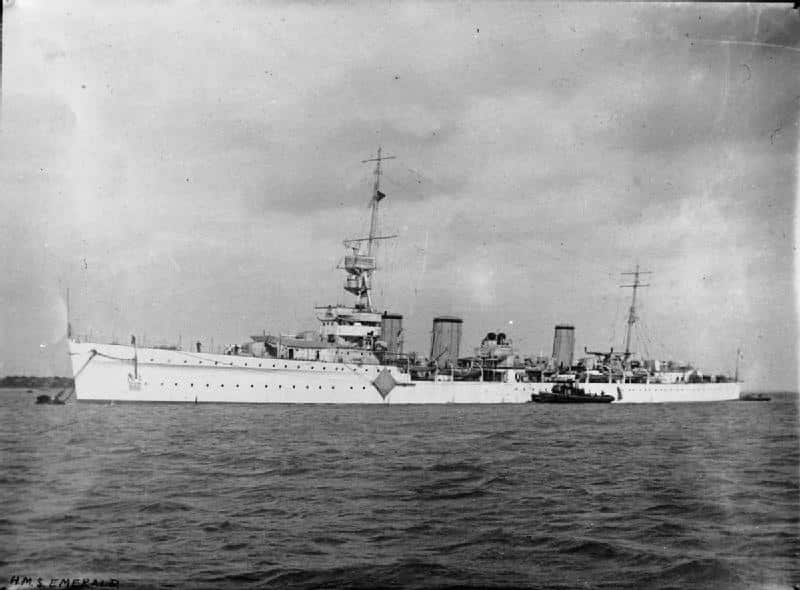
HMS Emerald in the interwar. The livery would have been white/pale grey with dark sand superstructures
Considerations about the class
All in all, the Emerald class in 1939 could have been obsolete and costly compared to new classes, but they were still the fastest cruisers in the Royal Navy and the heaviest torpedo-armed at the outbreak of World War II.
They were made “bankable” in the interwar and still found their place in the Navy despite the arrival of the large “County” colonial cruisers and the modern “Town” class to chasing German raiders thanks to their long range.
They very much had the same fate and career as the “C” or Cavendish class, mainly employed on the ocean trade routes and the Far East in 1942-43 with the East Indies Fleet. The small but successful naval battle of the Enterprise against a well-armed German destroyer and torpedo boat force in December 1943 in the Bay of Biscay was considered a feat for such an old cruiser.
Links
The HMS Enterprise on wikipedia
British Light Cruisers 1939–45 By Angus Konstam
British Cruisers: Two World Wars and After. By Norman Friedman
wwiivehicles.com/great-britain/ships/cruisers/e-class-cruisers.asp
uboat.net/allies/warships/ship/1215.html
Specs Conway’s all the world fighting ships 1921-1947.
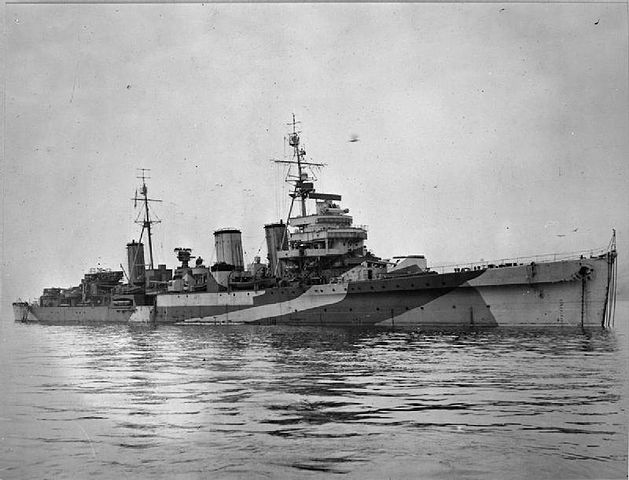
HMS Enterprise in November 1943
Neptune specifications |
|
| Dimensions | 173.7 x16.6 x6.6 m (570 x54 x16 ft) |
| Displacement | 8250 tons S, 10220 tons FL |
| Crew | 680 |
| Propulsion | 4 screws, 4 BC turbines, 8 Yarrow boilers, 80,000 hp |
| Speed | 33 knots (61 km/h; 38 mph) |
| Range | 1,350nm @32 knots to 8,000nm @15 knots |
| Armament | 7x 152mm, 5x 102mm MK VIII AA, 8 Bofors 40mm AA, 16(4×4) TT 533mm |
| Armor | Sides 38-76 mm (1.5-3 in), deck 25 mm (1 in). |
Gallery
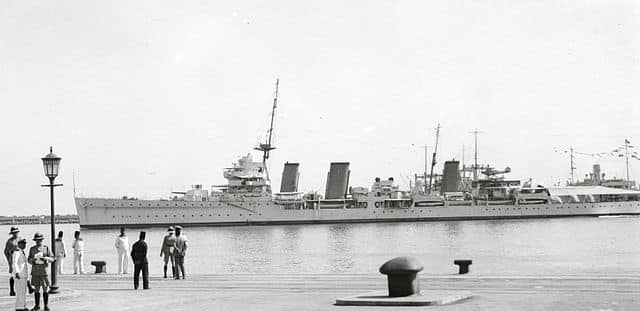
Profile of the HMS Enterprise at Haifa in 1936
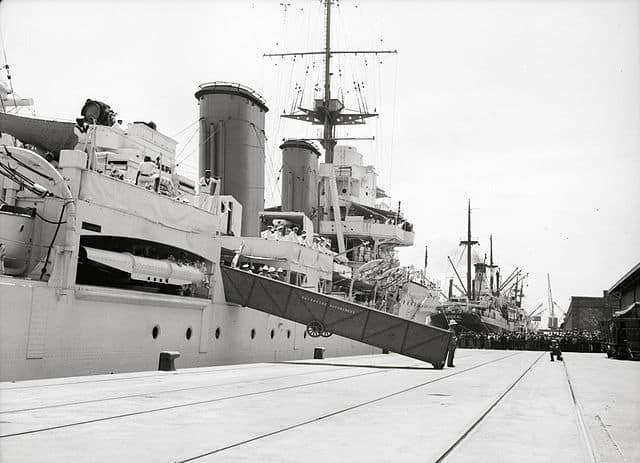
Same, port side view

HMS Enteprise in June 1944, operation Overlord.



 Latest Facebook Entry -
Latest Facebook Entry -  X(Tweeter) Naval Encyclopedia's deck archive
X(Tweeter) Naval Encyclopedia's deck archive Instagram (@navalencyc)
Instagram (@navalencyc)





 French Navy
French Navy Royal Navy
Royal Navy Russian Navy
Russian Navy Armada Espanola
Armada Espanola Austrian Navy
Austrian Navy K.u.K. Kriegsmarine
K.u.K. Kriegsmarine Dansk Marine
Dansk Marine Nautiko Hellenon
Nautiko Hellenon Koninklije Marine 1870
Koninklije Marine 1870 Marinha do Brasil
Marinha do Brasil Osmanlı Donanması
Osmanlı Donanması Marina Do Peru
Marina Do Peru Marinha do Portugal
Marinha do Portugal Regia Marina 1870
Regia Marina 1870 Nihhon Kaigun 1870
Nihhon Kaigun 1870 Preußische Marine 1870
Preußische Marine 1870 Russkiy Flot 1870
Russkiy Flot 1870 Svenska marinen
Svenska marinen Søværnet
Søværnet Union Navy
Union Navy Confederate Navy
Confederate Navy Armada de Argentina
Armada de Argentina Imperial Chinese Navy
Imperial Chinese Navy Marinha do Portugal
Marinha do Portugal Mexico
Mexico Kaiserliche Marine
Kaiserliche Marine 1898 US Navy
1898 US Navy Sovietskiy Flot
Sovietskiy Flot Royal Canadian Navy
Royal Canadian Navy Royal Australian Navy
Royal Australian Navy RNZN Fleet
RNZN Fleet Chinese Navy 1937
Chinese Navy 1937 Kriegsmarine
Kriegsmarine Chilean Navy
Chilean Navy Danish Navy
Danish Navy Finnish Navy
Finnish Navy Hellenic Navy
Hellenic Navy Polish Navy
Polish Navy Romanian Navy
Romanian Navy Turkish Navy
Turkish Navy Royal Yugoslav Navy
Royal Yugoslav Navy Royal Thai Navy
Royal Thai Navy Minor Navies
Minor Navies Albania
Albania Austria
Austria Belgium
Belgium Columbia
Columbia Costa Rica
Costa Rica Cuba
Cuba Czechoslovakia
Czechoslovakia Dominican Republic
Dominican Republic Haiti
Haiti Hungary
Hungary Honduras
Honduras Estonia
Estonia Iceland
Iceland Eire
Eire Equador
Equador Iran
Iran Iraq
Iraq Latvia
Latvia Liberia
Liberia Lithuania
Lithuania Mandchukuo
Mandchukuo Morocco
Morocco Nicaragua
Nicaragua Persia
Persia San Salvador
San Salvador Sarawak
Sarawak Uruguay
Uruguay Venezuela
Venezuela Zanzibar
Zanzibar Warsaw Pact Navies
Warsaw Pact Navies Bulgaria
Bulgaria Hungary
Hungary

 Bundesmarine
Bundesmarine Dutch Navy
Dutch Navy Hellenic Navy
Hellenic Navy Marina Militare
Marina Militare Yugoslav Navy
Yugoslav Navy Chinese Navy
Chinese Navy Indian Navy
Indian Navy Indonesian Navy
Indonesian Navy JMSDF
JMSDF North Korean Navy
North Korean Navy Pakistani Navy
Pakistani Navy Philippines Navy
Philippines Navy ROKN
ROKN Rep. of Singapore Navy
Rep. of Singapore Navy Taiwanese Navy
Taiwanese Navy IDF Navy
IDF Navy Saudi Navy
Saudi Navy Royal New Zealand Navy
Royal New Zealand Navy Egyptian Navy
Egyptian Navy South African Navy
South African Navy






























 Ukrainian Navy
Ukrainian Navy dbodesign
dbodesign
2 thoughts on “Enterprise class cruisers”
Comments are closed.